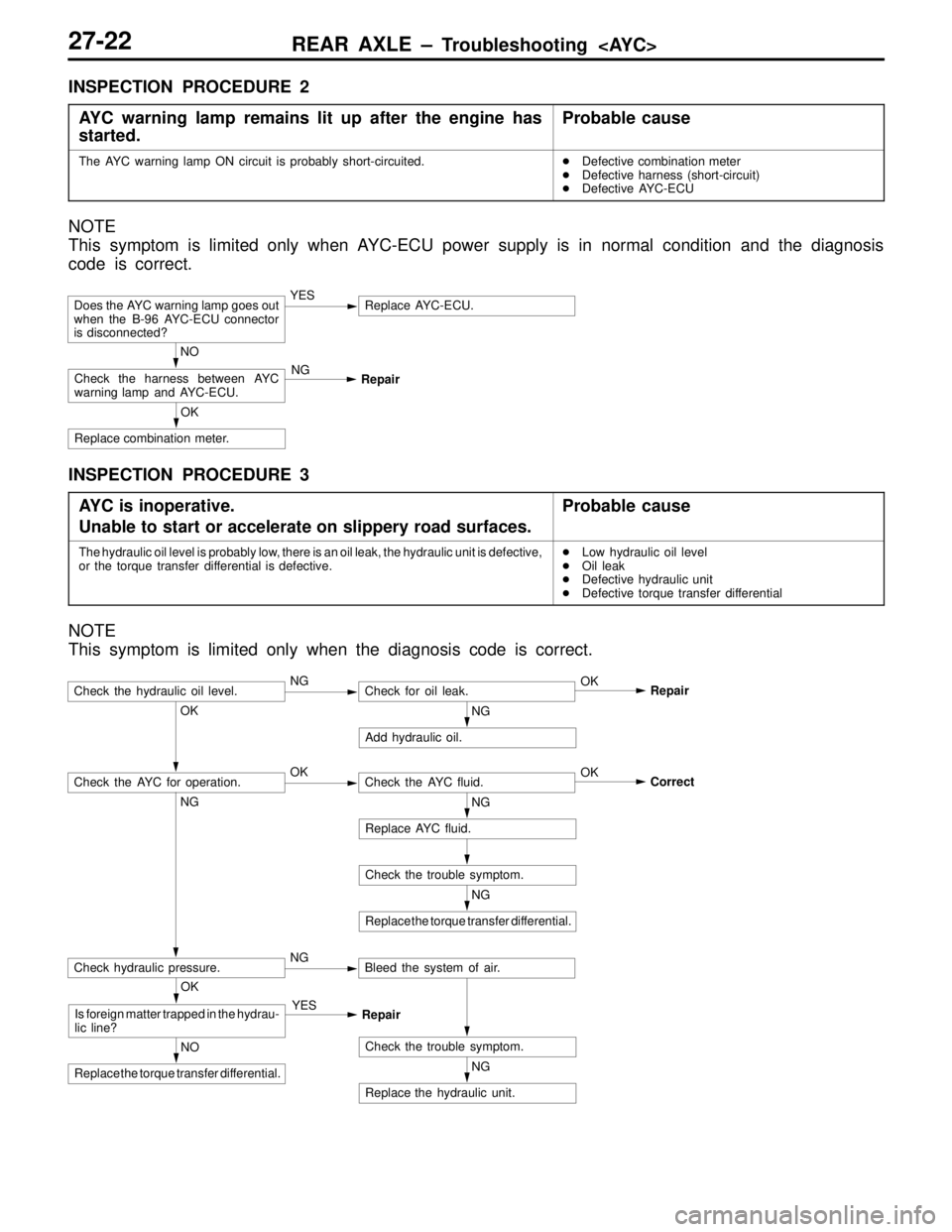Page 208 of 396

REAR AXLE – Troubleshooting 27-22
INSPECTION PROCEDURE 2
AYC warning lamp remains lit up after the engine has
started.
Probable cause
The AYC warning lamp ON circuit is probably short-circuited.�Defective combination meter
�Defective harness (short-circuit)
�Defective AYC-ECU
NOTE
This symptom is limited only when AYC-ECU power supply is in normal condition and the diagnosis
code is correct.
OK
Replace combination meter.
NO
Check the harness between AYC
warning lamp and AYC-ECU.NG
Repair
Does the AYC warning lamp goes out
when the B-96 AYC-ECU connector
is disconnected?YESReplace AYC-ECU.
INSPECTION PROCEDURE 3
AYC is inoperative.
Unable to start or accelerate on slippery road surfaces.
Probable cause
The hydraulic oil level is probably low, there is an oil leak, the hydraulic unit is defective,
or the torque transfer differential is defective.�Low hydraulic oil level
�Oil leak
�Defective hydraulic unit
�Defective torque transfer differential
NOTE
This symptom is limited only when the diagnosis code is correct.
NG
Replace the hydraulic unit.
NG
Replace the torque transfer differential.
Check the trouble symptom.
NG
Replace AYC fluid.
OK
Correct
Check the trouble symptom.NO
Replace the torque transfer differential.
OK
Is foreign matter trapped in the hydrau-
lic line?YES
Repair
OK
Check the AYC for operation.OKCheck the AYC fluid.
NG
Add hydraulic oil.
NG
Check hydraulic pressure.NGBleed the system of air.
Check the hydraulic oil level.NGCheck for oil leak.OK
Repair
Page 307 of 396

STEERING – Service Specifications / Special Tools / On-vehicle Service37A-2
SERVICE SPECIFICATIONS
ItemsStandard value
Steering angleEVOLUTION-IVInner wheel33�30’ ± 2�
Outer wheel28�20’
EVOLUTION-VInner wheel33�10’ ± 2�
Outer wheel28�10’
Steering gearPinion total turning torque
Nm {kgfcm}
Total turning torque0.9 – 1.7 {9 – 17}
Nm {kgf�cm}Torque fluctuations0.4 {4} or less
SPECIAL TOOLS
ToolNumberNameUse
MB991197Installer barPressfitting of gear housing oil seal
MB991199Oil seal installer
MB991214Oil seal protectorInstallation of rack assembly
ON-VEHICLE SERVICE
1. STEERING ANGLE CHECK
Locate front wheels on turning radius gauge and measure
steering angle.
Standard value:
Inner wheel
33�30’ ± 2�
33�10’ ± 2�
Outer wheel
28�20’
28�10’
When the angle is not within the standard value, the toe
is probably incorrect. Adjust toe (Refer to GROUP 33A –
On-vehicle Service) and recheck steering angle.
2. OIL PUMP BELT TENSION CHECK AND
ADJUSTMENT
Refer to GROUP 11 – Engine Adjustments.
Page 369 of 396

CHASSIS ELECTRICAL – Combination Meters54-25
Inspection Procedure 2
Tachometer does not work.
Probable cause
The ignition signal may not be input from the engine, or there may be a malfunction
in the power supply or earth circuit.�Malfunction of tachometer
�Malfunction of harness or connector
Disconnect the combination meter con-
nector B-08 and measure at the harness
sides.
1. Measure the voltage between
terminal No.33 and earth.
OK: 5 V
2. Continuity between the terminal
No.34 and earth
OK: Continuity
3. Voltage between the terminal No.42
and earth
OK: System voltage1. NGCheck the following connectors.
B-08, A-36, B-61, B-64, A-41, A-109NG
Repair
OK
Check trouble symptom.NGCheck the harness between the engine-
ECU and combination meter, and repair
if necessary.
2. NGCheck the following connectors.
B-08, B-50, B-64, A-41NG
Repair
OK
Check trouble symptom.NGCheck the harness between the com-
bination meter and the body earth, and
repair if necessary. OK
Replace the tachometer.
3. NG
Check the following connectors.
B-08, B-75, B-76NG
Repair
OK
Check trouble symptom.NGCheck the harness between the power
supply and combination meter, and
repair if necessary.
YESRefer to Group 13 – Troubleshooting,
No. 44 Ignition coils and power
transistors.
OK
MUT-II Self-Diag code
Is the diagnosis code 44 relating to MPI
system output?
Page 389 of 396

CHASSIS ELECTRICAL – Radio and Tape Player54-45
RADIO AND TAPE PLAYER
TROUBLESHOOTING
There is noise when the engine is running.
Kind of Noise (Parenthe-
sized is how noise
sounds.)SymptomCauseRemedy
AM, FM: Ignition noise
(Popping, snapping,
crackling, buzzing)�Popping sound becomes
faster with the increase
of engine speed.
�The noise is lost with
ignition switch turned to
ACC.�Mainly due to the
spark plugs.
�Due to noise circula-
tion from elsewhere
�Noise from the engineCheck the noise capacitor
and earth cable and
replace if necessary. (See
Fig. 1 and Fig. 2.)
AM, FM: Defogger noise
(1) (Murmuring)Occurs when the defogger
switch is turned to ON and
OFF.Noise produced by spark-
ing when the defogger
switch is turned to ON/
OFF enters the glass
antenna.Check the noise capacitor
and replace if necessary.
(See Fig. 1.)
AM, FM: Defogger noise
(2) (Snapping noise)Occurs when the defogger
switch is turned to ON.Noise produced by current
flowing in the defogger
enters the glass antenna.Check the choke coil and
replace if necessary.
(See Fig. 3.)
AM, FM: Defogger noise
(3) (Scratching, gaggling)Occurs when the defogger
switch is turned to ON with
print heater wire broken.Noise produced by spark-
ing where print heater is
broken enters the glass
antenna.Repair the print heater.
AM, FM: Wiper motor
noise (Humming, wheez-
ing)Sound becomes faster with
the increase of wiper speed
and is lost when the wiper is
stopped.Caused by sparking in
wiper motor brush.Replace the wiper motor.
FM: Mirror motor noise
(Humming, wheezing)Occurs when electric mirror
operates.Caused by sparking in
mirror motor brush.Replace the electric
motor.
Other electrical compo-
nents–Noise is emitted by some
electrical components in
long use.Repair or replace electri-
cal components.
Static electricity (Crack-
ling, crinkling)�Noise is stopped when
the vehicle comes to a
complete stop.
�Noise becomes louder
when the clutch is
released.Occurs when parts or
wiring move for some
reason and contact metal
parts of the body.Put parts or wiring into
position.
Various noises are produced
by body parts.Due to electrical detach-
ment of the hood, exhaust
pipe and muffler, suspen-
sion, etc. from the body.Tighten mounting bolts
securely. In many cases,
remedy of one part does
not eliminate the problem
due to incomplete earthing
elsewhere.
Caution
(1) Never let the noise filter contact a high tension cable. The noise filter could break down.
(2) Check that there is no external noise. This check is necessary to prevent misidentification of noise
sources.
(3) Noise prevention should be performed by eliminating noise sources in the descending order of loudness.